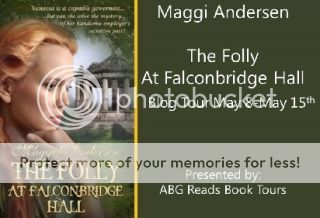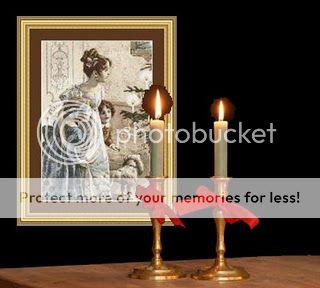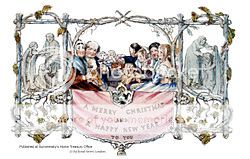Thank you for inviting me to your blog. As The Folly at Falconbridge Hall is set in the late Victorian era, and features a Christmas scene, I thought I’d say a little about how the Victorians spent their Christmas.
A Victorian Christmas
At the beginning of the 19th century, Christmas was hardly celebrated and many businesses did not even consider it a holiday. However, by the end of the century, it became the biggest annual celebration and much like our Christmases today.
The transformation happened quite fast, and came from all sectors of society.
After her marriage to the German-born Prince Albert, Queen Victoria introduced some of the most prominent aspects of Christmas. In 1848, the Illustrated London News published a drawing of the royal family celebrating around a decorated Christmas tree, a tradition that was reminiscent of Prince Albert's childhood in Germany. Soon every home in Britain had a tree bedecked with candles, sweets, fruit, homemade decorations and small gifts.
Victoria and Albert gathered around the Christmas tree with their children.
Santa Claus first made an appearance in British society during Queen Victoria’s reign when the wealthy middle class generated by the industrial revolution changed the face of Christmas forever. Father Christmas was originally part of an old English midwinter festival, normally dressed in green, a sign of the returning spring. The stories of St. Nicholas (Sinter Klaas in Holland) came via Dutch settlers to America in the 17th Century. From 1870, Sinter Klass became known in Britain as Santa Claus with his bag full of gifts and toys distributed by reindeer and sleigh.
Inspired by Charles Dickens Christmas Carol published in 1843, the wealthy gave money and gifts to the poor at Christmas.
Christmas Day and Boxing Day became holidays. Boxing Day was so named because the poor opened the boxes containing gifts and money from their wealthy benefactors. The railways allowed those now living and working in the cities to return to the country for Christmas.
With factories came mass production, which produced less expensive games, dolls, books and clockwork toys than the handmade variety. Children of poorer families might have found an apple, orange and a few nuts in their Christmas stocking, which became popular from around 1870.
Turkeys originated from America and had been in Britain for hundreds of years before the Victorian era, but along with chicken, they were too expensive at the beginning of Queen Victoria’s reign. Roast beef was traditional fare in northern England and in the south goose was eaten. Queen Victoria and family in 1840 enjoyed both beef and a royal roast swan or two. By the end of the century, most people feasted on turkey for their Christmas dinner.
The "Penny Post" was first introduced in Britain in 1840 by Rowland Hill. The idea was simple, a penny stamp paid for the postage of a letter or card to anywhere in Britain. This simple idea paved the way for the sending of the first Christmas cards. Sir Henry Cole tested the water in 1843 by printing a thousand cards for sale in his art shop in London at one shilling each.
Tom Smith, a London sweet maker in 1846 invented crackers. The original idea was to wrap his sweets in a twist of fancy colored paper, but this developed and sold much better when he added love notes (motto's), paper hats, small toys and made them go BANG!
Carol Singers and Musicians "The Waits" visited houses singing and playing the new popular carols:
1843 - O Come all ye Faithful
1848 - Once in Royal David's City
1851 - See Amid the Winters Snow
1868 - O Little Town of Bethlehem
1883 - Away in a Manger
Here’s part of the scene in The Folly at Falconbridge Hall, when Vanessa’s uncle comes to call:
On Christmas Eve, snow gathered in great drifts, softening and muffling the landscape. It was pretty, and a white Christmas would have been enjoyable but for the big hole in their lives, Julian’s absence had made.
When Vanessa visited the kitchen to stir the sixpences into the plum pudding, she found it decked out with holly. Cook was busy making mincemeat and wassail and preparing oyster stuffing for the goose. The house was filled with good cheer, which made Vanessa miss Julian even more. She busied herself organizing the staff bonuses and gift boxes and buying Blythe’s presents, which were hidden in her wardrobe. Now that everything was under control, she had time to reflect on how small their family was. Would there be more children around the table in coming years? She prayed it would be so.
Vanessa and Blythe dressed the tall pine Christmas tree in the corner of the drawing room. Bright red stockings hung on the fireplace mantel. The house had taken on a festive air, as if willing it to be a good Christmas. Vanessa doubted even Blythe was fooled by it.
A carriage came down the drive. Moments later, the knocker was sharply rapped.
“The Earl of Gresham, my lady,” Johnson announced.
Stunned, Vanessa clambered to her feet, holding a colored globe as the well-dressed man entered followed by a footman, his arms full of wrapped gifts.
“Uncle William, how nice to see you.” Vanessa hurried to kiss his cheek.
“And you, my dear.”
Her uncle dismissed his servant and accepted the offer of a hot cider to warm him.
She introduced Blythe to her uncle. He smiled and nodded at her.
“The tree still looks a bit bare, Blythe. Could you seek out Mrs. Royce and ask her to find more tinsel? And then go to the nursery, I’ll be up directly.”
Blythe curtsied sweetly and left the room. “A pretty child,” he said, gazing after her. “Her mother was a friend of my wife’s.”
“Was she?”
“I shouldn’t speak ill of the dead.”
 Title: The Folly At Falconbridge Hall
Title: The Folly At Falconbridge Hall Author: Maggi Andersen
Genre: Historical Mystery Romance
Publisher: Knox Robinson Publishing
Number of Pages: 350
Blurb:
Vanessa Ashley felt herself qualified for a position as governess, until offered the position at Falconbridge Hall. Left penniless after the deaths of her artist father and suffragette mother, Vanessa Ashley draws on her knowledge of art, politics and history to gain employment as a governess. She discovers that Julian, Lord Falconbridge, requires a governess for his ten-year-old daughter Blyth at Falconbridge Hall, a huge rambling mansion in the countryside outside London. Lord Falconbridge is a scientist and dedicated lepidopterist who is about to embark on an extended expedition to the Amazon in search of exotic butterflies. An enigmatic man, he takes a keen interest in his daughter's education, but Vanessa feels that he may disapprove of her modern methods. As she prepares her young charge to enter into the modern world, Vanessa finds the girl detached and aloof. As Vanessa learns more about Falconbridge Hall, more questions arise. Why doesn't Blythe feel safe in her own home? Why is the death of her mother, once famed society beauty Clara, never spoken of? And why did the former governess leave so suddenly without giving notice.
Buy Links: Amazon US | B&N | Book Depository
Where to find the author:
Amazon Author Page | Facebook | Good Reads | Twitter
Author Bio:
Maggi Andersen and her lawyer husband are empty nesters, living in the countryside outside Sydney with their cat and the demanding wildlife. Parrots demand seed, possums fruit, ducks swim in the stream at the bottom of the garden, and the neighbours chickens roam their yard providing wonderful eggs. She began writing adventure stories at age eight. Three children, a Bachelor of Arts degree and a Master of Arts in Creative Writing degree later, her novels are still filled with adventure and suspense, but are also passionate romances. Georgette Heyer among others, brought inspiration to her seductive Regencies and she also writes darker, Victorian novels, contemporary romantic suspense and young adult.








Thanks for featuring me on your blog.
ReplyDelete